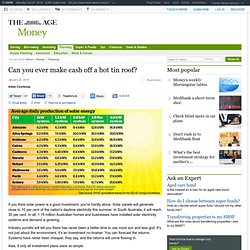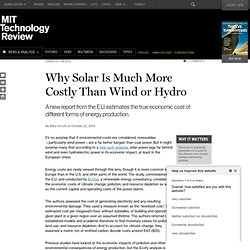

The Economic Way of Thinking. Technology Energy Efficiency. How To Calculate Solar Power Cost Per KWH. With the rise in awareness of solar energy, many people are looking to make a switch, but want to understand the solar power cost per kwh before making a final decision.

Indeed, this is a very important calculation because it is going to be the determining factor in what your overall energy cost savings will be if you switch to solar. First, we must define a kilowatt hour, or kwh. This is simply the way we measure electricity. Just as when you purchase gas, you measure in gallons, when using electricity, you’re measuring in kwh. In order to come up with the kwh, you need to take the wattage of a given device and multiply it by how many hours you use it. You now have watts per hour; in order to get to kilowatts, you just need to divide the result by 1000. Can you ever make cash off a hot tin roof?
If you think solar power is a good investment, you're hardly alone.

Solar panels will generate close to 10 per cent of the nation's daytime electricity this summer. In South Australia, it will reach 30 per cent. In all, 1.15 million Australian homes and businesses have installed solar electricity systems and demand is growing. Industry pundits will tell you there has never been a better time to use more sun and less grid.
It's not just about the environment, it's an investment no-brainer. Alas, if only all investment plans were so simple. Can you ever make cash off a hot tin roof? For solar to be a viable investment - and it has the potential - it needs to be understood. Advertisement What the government once gave, it has since taken away. Zoya Sheftalovich, a researcher at Choice magazine, which has been examining solar investment returns for the past four years, says solar modesty is now the best policy - the best system is one which simply matches basic household needs. Facts pack: Electricity price and solar energy in Australia 2014 - Solar Choice. The newspapers are full of stories about electricity costs and it’s no wonder because prices have increased by as much as 33% in some states in the last three years.

The reasons our electricity prices have increased so much is complicated but if you would like to understand the makeup of an average bill you can read the Australian Energy Market Commission’s (AEMC’s) latest report here (PDF). Many people we talk to say to us: “We don’t understand – we have reduced our energy consumption, use energy efficient appliances and yet our bill keeps rising. What’s going on?” The simple fact is that with national average costs now hovering around $0.28c kWh, you have two choices – change your supplier or reduce your demand even more. Recent reports show that changing from a regulated tariff to a market offer tariff, which essentially means shopping around and signing up to a new contract which could save between 3% and 16% depending on what you have and what you are eligible for. Nigel Morris.
Environmental Cost Makes Wind Cheaper Than Coal in Europe. It’s no surprise that if environmental costs are considered, renewables—particularly wind power—are a far better bargain than coal power.

But it might surprise many that according to a new such analysis, solar power lags far behind wind and even hydroelectric power in its economic impact, at least in the European Union. Energy costs are rarely viewed through this lens, though it is more common in Europe than in the U.S. and other parts of the world. The study, commissioned by the E.U. and conducted by Ecofys, a renewable energy consultancy, considered the economic costs of climate change, pollution, and resource depletion as well as the current capital and operating costs of the power plants. The authors assessed the cost of generating electricity and any resulting environmental damage. They used a measure known as the “levelized cost,” the estimated cost per megawatt-hour, without subsidies, of building and operating a given plant in a given region over an assumed lifetime.